Road salt in winter and ocean spray in beachside gardens can pose particular problems for gardeners. In high salt environments, many plants will stop growing, turn brown, or wither and die away entirely. Finding plants that grow in soil with higher levels of salt can be a challenge, but we’re here to help!
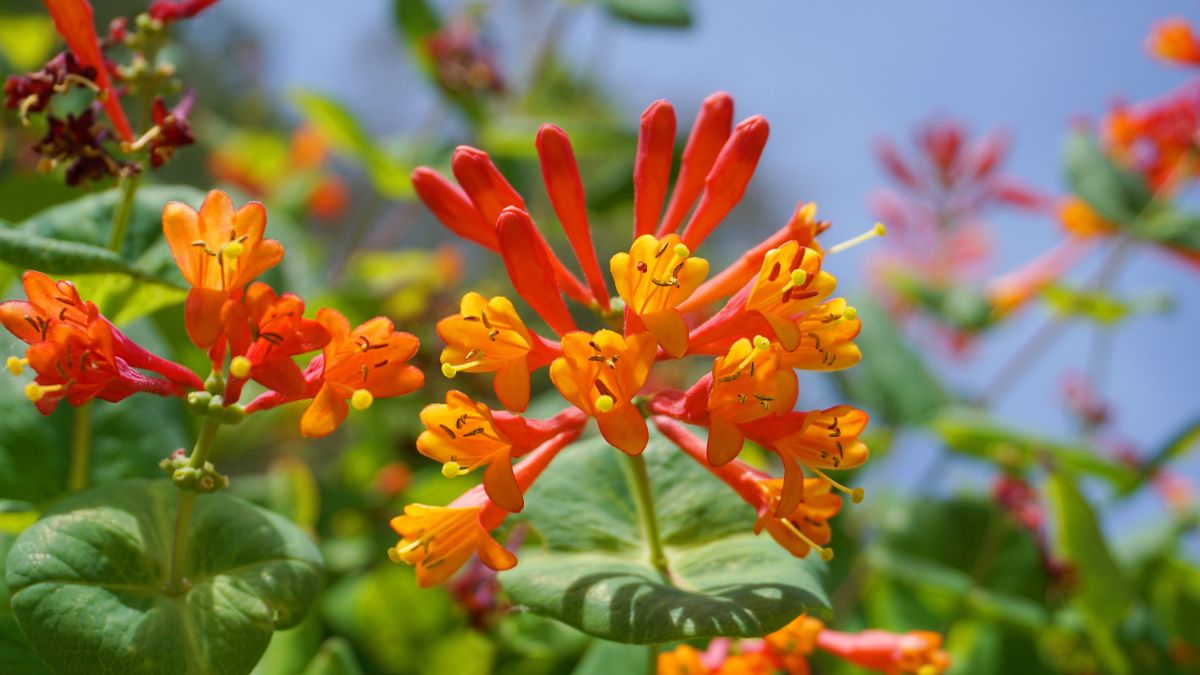
In this guide, we’ll reveal some of the most salt-tolerant plants around. Whether you live in a cold climate where icy roads are treated with road salt, or you’re growing a garden in a tropical area by the sea, you’ll find the best plants for your flower beds right here!
Jump to:
- 18 salt-tolerant plants for roadways and coastal gardens
- 1. Beach rose (Rosa rugosa)
- 2. Hydrangea (Hydrangea macrophylla)
- 3. Eastern Red Cedar (Juniperus virginiana)
- 4. Oaks (Quercus spp.)
- 5. Adam’s Needle (Yucca filamentosa)
- 6. Butterfly Weed (Asclepias tuberosa)
- 7. Blueberries (Vaccinium spp.)
- 8. Columbine (Aquilegia spp.)
- 9. Beach Sunflower (Helianthus debilis)
- 10. Hibiscus (Hibiscus spp.)
- 11. Staghorn Sumac (Rhus typhina)
- 12. Blanket Flower (Gaillardia spp.)
- 13. Coral Honeysuckle (Lonicera sempervirens)
- 14. Ornamental Grasses
- 15. Oleander (Nerium oleander)
- 16. Asters (Aster spp.)
- 17. Goldenrod (Solidago spp.)
- 18. Daylilies (Hemerocallis spp.)
- Summary
18 salt-tolerant plants for roadways and coastal gardens
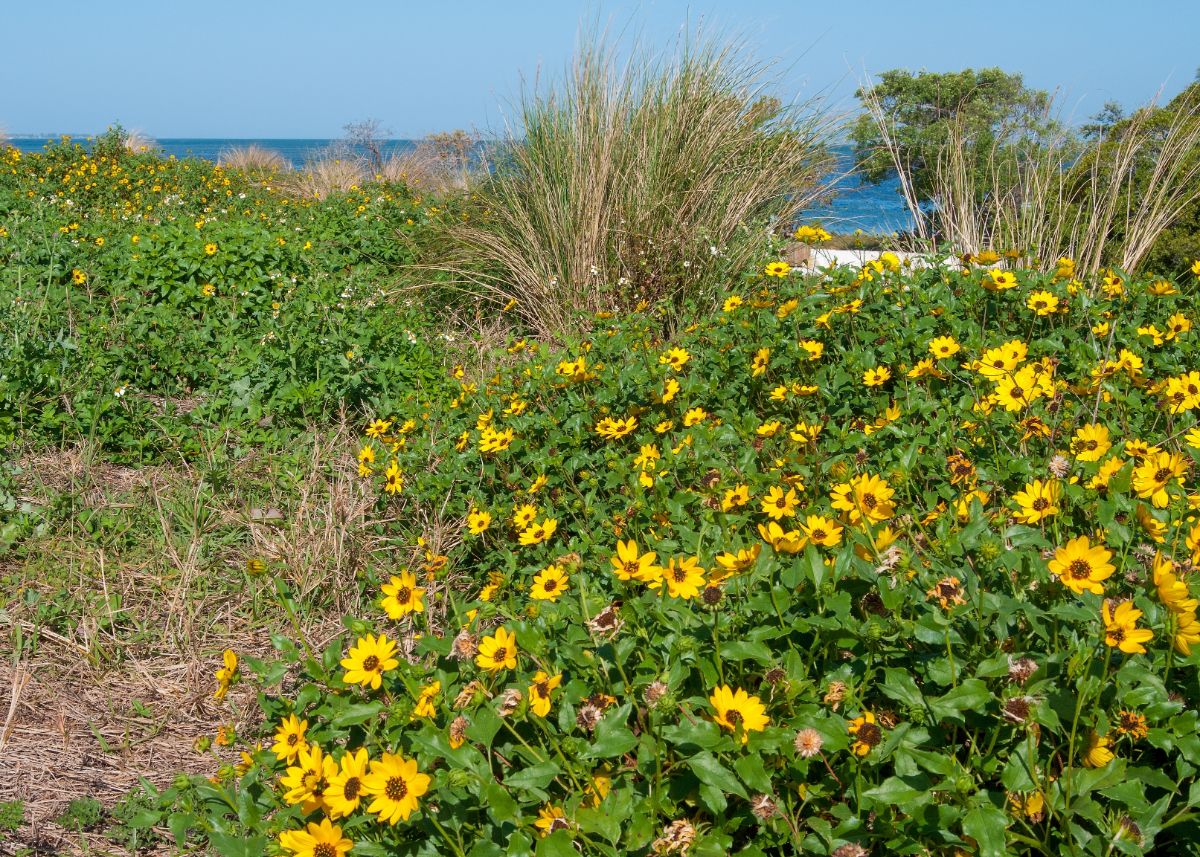
Salt can inhibit nitrogen absorption in plants and cause other problems too. Luckily, if you live in a coastal area or are looking for plants to grow near roadways, there are plenty of salt-tolerant plants to try!
1. Beach rose (Rosa rugosa)
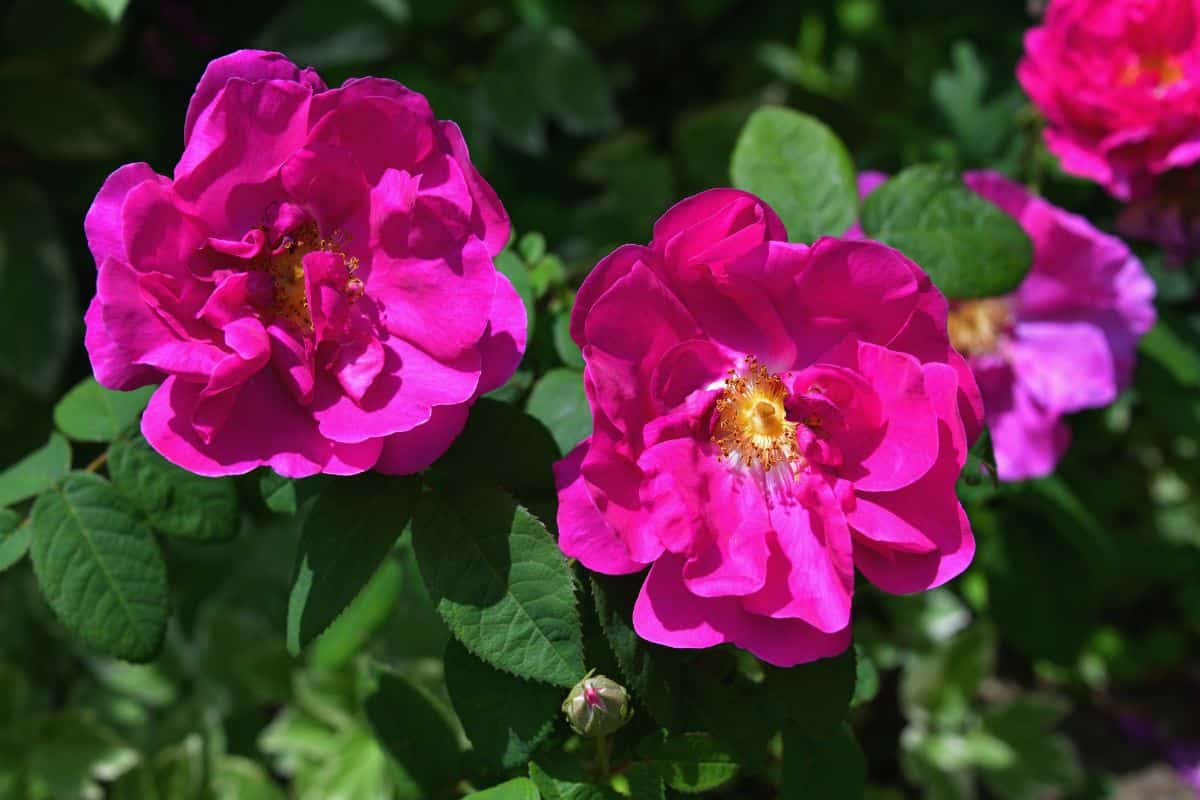
| Plant name: | Beach rose |
| Light requirements: | Full sun to part shade |
| Water requirements: | Moderate to low |
| Growing zone: | Zones 3 to 9 |
| Notable features: | Edible rosehips |
Beach roses are some of the most rugged plants you can find, and when it comes to salt-tolerant plants, they’re at the top of the list for a good reason. These plants often grow on their own on sand dunes and along beach paths, but you can also plant them in your garden! Try out beach roses along your fence or walkway and enjoy their large, fragrant blooms that come in pink, white, and red.
While these plants may look delicate, they do have thorns, so you’ll want to be conscious of where you plant them in the garden. In autumn, beach roses also produce large harvests of edible rosehips, which are said to be the best-tasting and sweetest rosehips around!
2. Hydrangea (Hydrangea macrophylla)
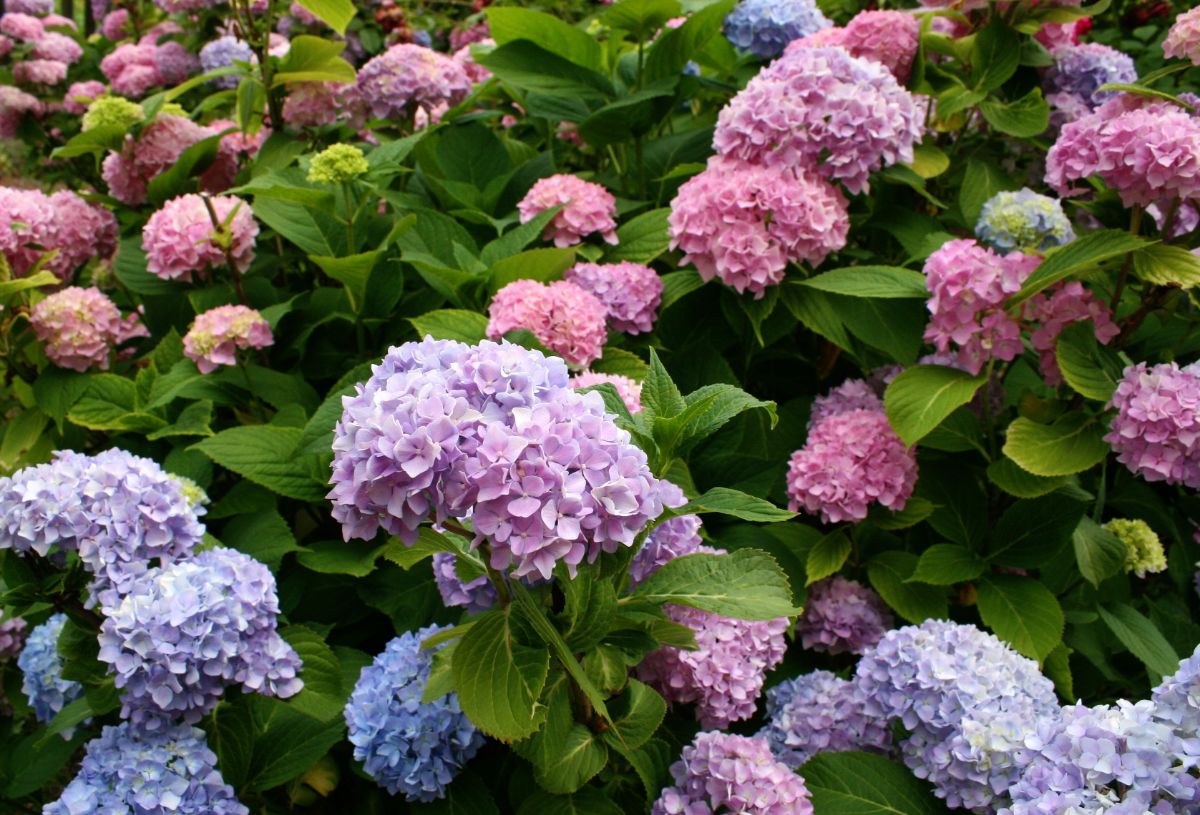
| Plant name: | Hydrangea |
| Light requirements: | Full sun to part shade |
| Water requirements: | Moderate |
| Growing zone: | Depends on variety |
| Notable features: | Large, color-changing flower heads; Good for dried flowers |
Like beach roses, hydrangeas are commonly grown in coastal gardens where their oversized blooms mirror the changing colors of the sea and sky. But while hydrangeas can handle some salt spray, not all hydrangeas are equally salt tolerant. One study found that bigleaf hydrangeas have the best salt tolerance, and the cultivars ‘Ayesha,’ ‘Selina’ and ‘Sabrina’ were the best choices for salty areas.
Bigleaf hydrangeas aren’t as cold-hardy as some other hydrangea varieties, and they mostly grow in zones 6 through 9, although you may be able to keep them in zone 5 with extra winter protection. These hydrangeas also have color-changing flowers that react to the pH of the soil. In acidic conditions, bigleaf hydrangeas will produce blue blooms, but in alkaline gardens, their flowers will develop pink coloration.
3. Eastern Red Cedar (Juniperus virginiana)

| Plant name: | Eastern red cedar |
| Light requirements: | Full sun |
| Water requirements: | Low |
| Growing zone: | Zones 2 to 9 |
| Notable features: | Drought tolerant; Evergreen color; Year round privacy; Ultra cold hardy |
When it comes to picking a landscaping plant that can handle road salt and winter sludge, eastern red cedars are another popular choice. These hardy plants can grow in areas as cold as zone 2, but they can also thrive in warmer climates. Plus, they provide evergreen color all year round, and they can even grow in poor soils!
Eastern red cedar trees grow up to 50’ tall when mature, but you can keep them smaller with pruning. There are also dwarf cedar varieties on the market today that only grow to about 3’ tall and make perfect foundation plants for hellstrip gardens and other roadside garden designs. In addition to their rich green foliage, eastern red cedars also produce bright blue berries in autumn that are always a hit with wild birds.
4. Oaks (Quercus spp.)
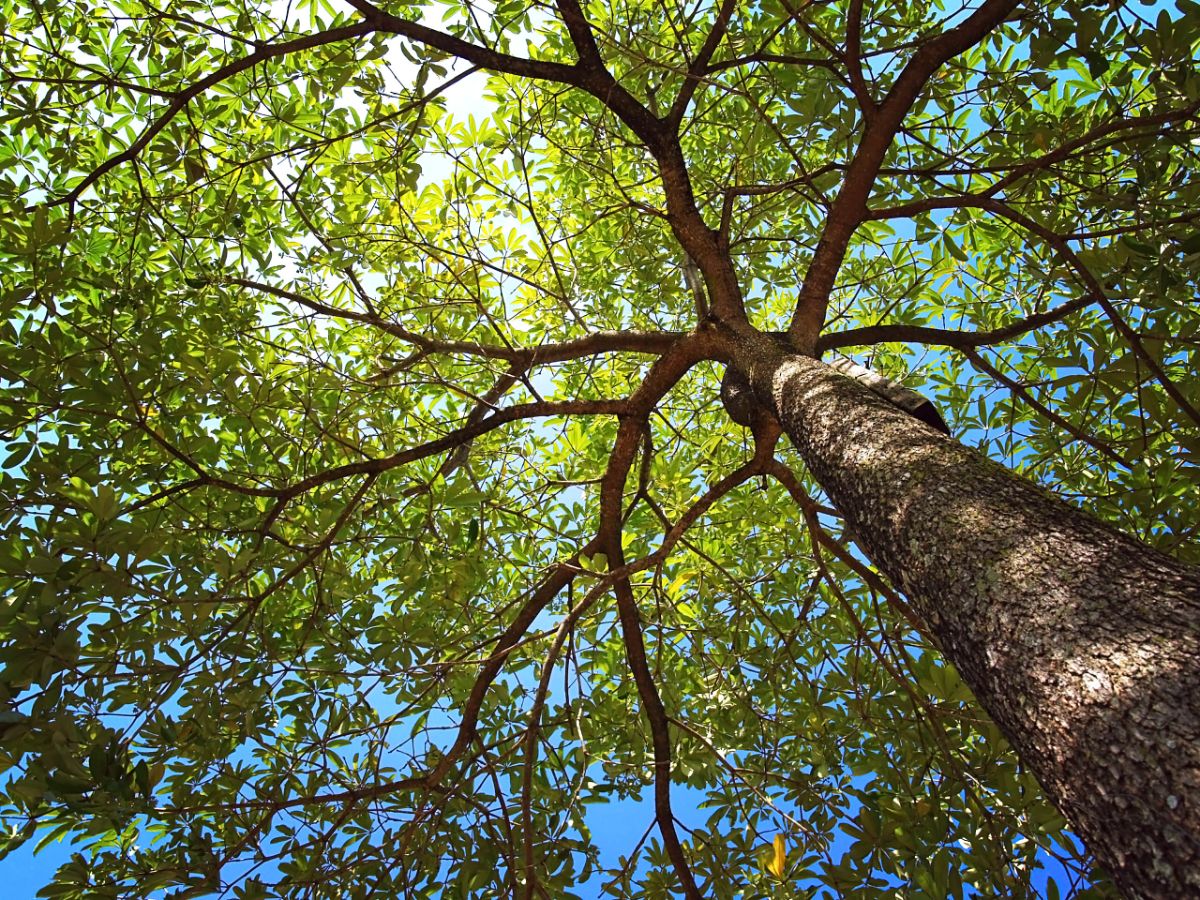
| Plant name: | Oaks |
| Light requirements: | Full sun |
| Water requirements: | Moderate to low |
| Growing zone: | Depends on variety |
| Notable features: | Keystone species; Good for wildlife |
Oaks are sturdy plants that are often grown along roadways, and they provide shade and structure to neighborhood streets. But some oaks are also quite salt tolerant, and they hold their own even in the face of winter ice and road salt.
Not all oaks are ideal for salty soil and beachside gardens, but pin oaks (Quercus palustris), white oaks (Quercus alba), and red oaks (Quercus rubra) will grow reliably in these settings. Oak trees are also known as “keystone species,” which support a massive amount of wildlife, including birds, insects, and rodents. Planting oaks along your property can help out pollinators and help restore habitats too.
5. Adam’s Needle (Yucca filamentosa)
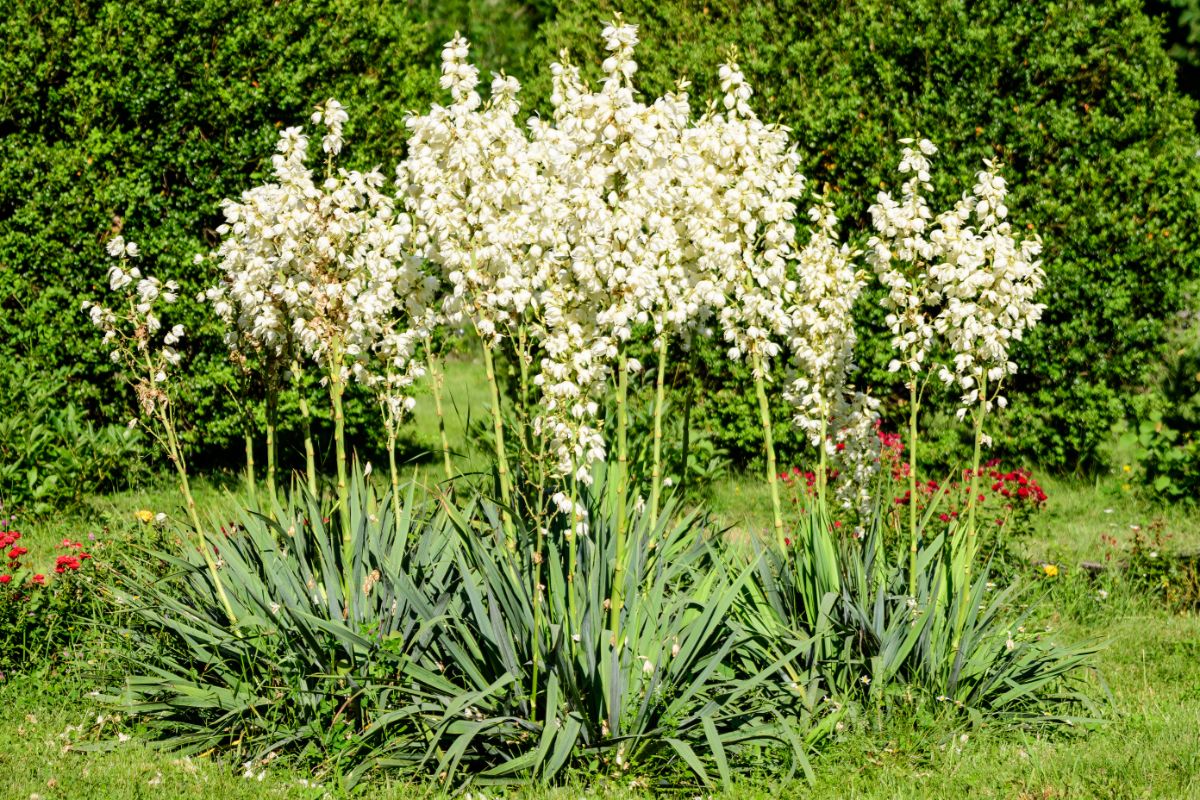
| Plant name: | Adam’s needle |
| Light requirements: | Full sun to part shade |
| Water requirements: | Low |
| Growing zone: | Zones 4 to 10 |
| Notable features: | Showy flowers; Evergreen color; Drought tolerant |
Adam’s needle may look like it belongs in the desert, but it can grow in climates as cool as zone 5, and it has become naturalized in New England and other chilly spots. These broadleaf evergreens are native to the southeastern United States, and they will grow happily in areas where many other plants won’t root. Specifically, Adam’s needle can handle poor and rocky soils, and it’s got a high salt tolerance too.
Adam’s needle is mostly grown for its large, spiked leaves that can add lots of color to your garden, but this plant also flowers when it’s mature. At around 4 to 5 years of age, Adam’s needle plants will produce a tall flower stalk that’s bursting with creamy white, bell-shaped flowers. And, if you needed more reasons to grow Adam’s needle, it’s also deer tolerant and has minimal watering needs!
6. Butterfly Weed (Asclepias tuberosa)
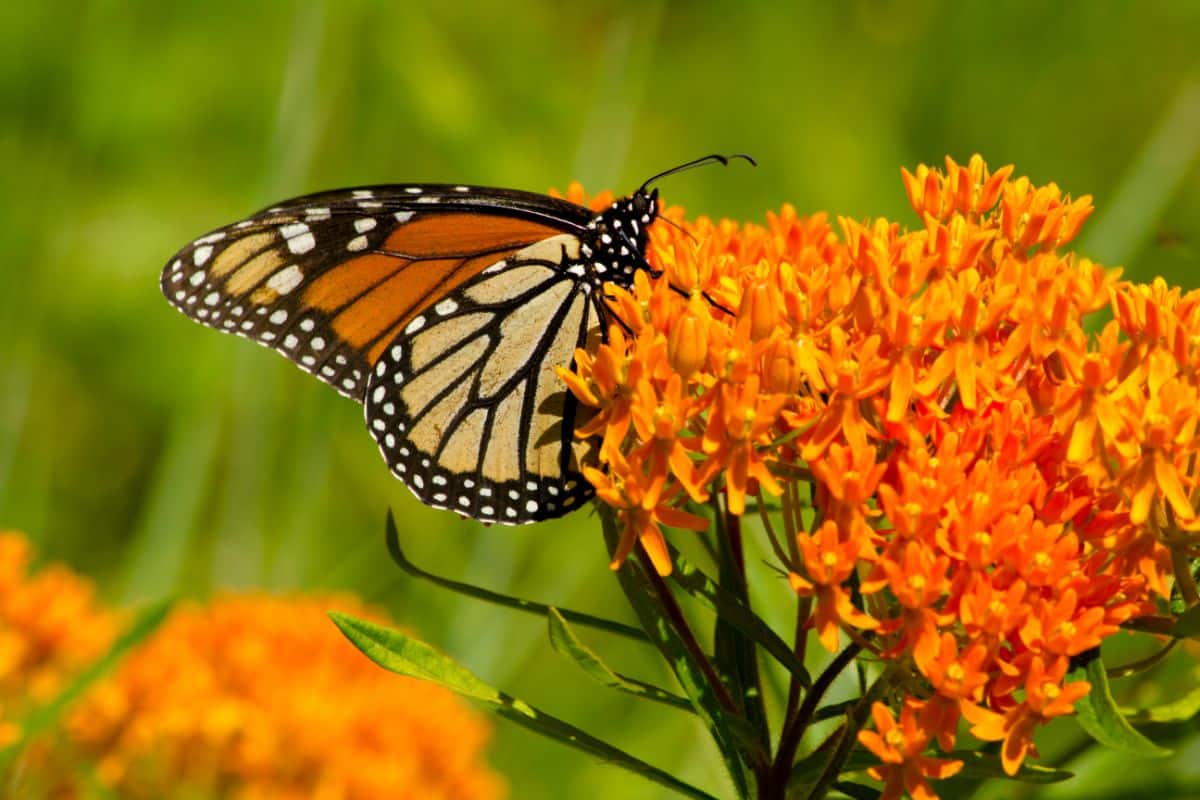
| Plant name: | Butterfly weed |
| Light requirements: | Full sun |
| Water requirements: | Moderate to low |
| Growing zone: | Zones 3 to 9 |
| Notable features: | Host plant for butterflies; Drought tolerant |
Butterfly weed isn’t as salt tolerant as some of the other plants on this list; however, it does display a moderate amount of salt resistance. That means it can be grown along roadways and in beachy areas as long as it doesn’t get inundated with tons of salt. A top pollinator plant, butterfly weed is hardy and quite cold resistant too, plus it’s an essential host plant for Queen and Monarch butterflies.
Butterfly weed has bright orange flowers that are impossible to miss in mixed bed arrangements. These plants are also drought tolerant once established, and they don’t need a lot of fuss or extra fertilizer. Create a pollinator-friendly roadside garden by growing butterfly weed with other hardy perennial plants, like blanket flower, lady’s mantle, and bee balm.
7. Blueberries (Vaccinium spp.)
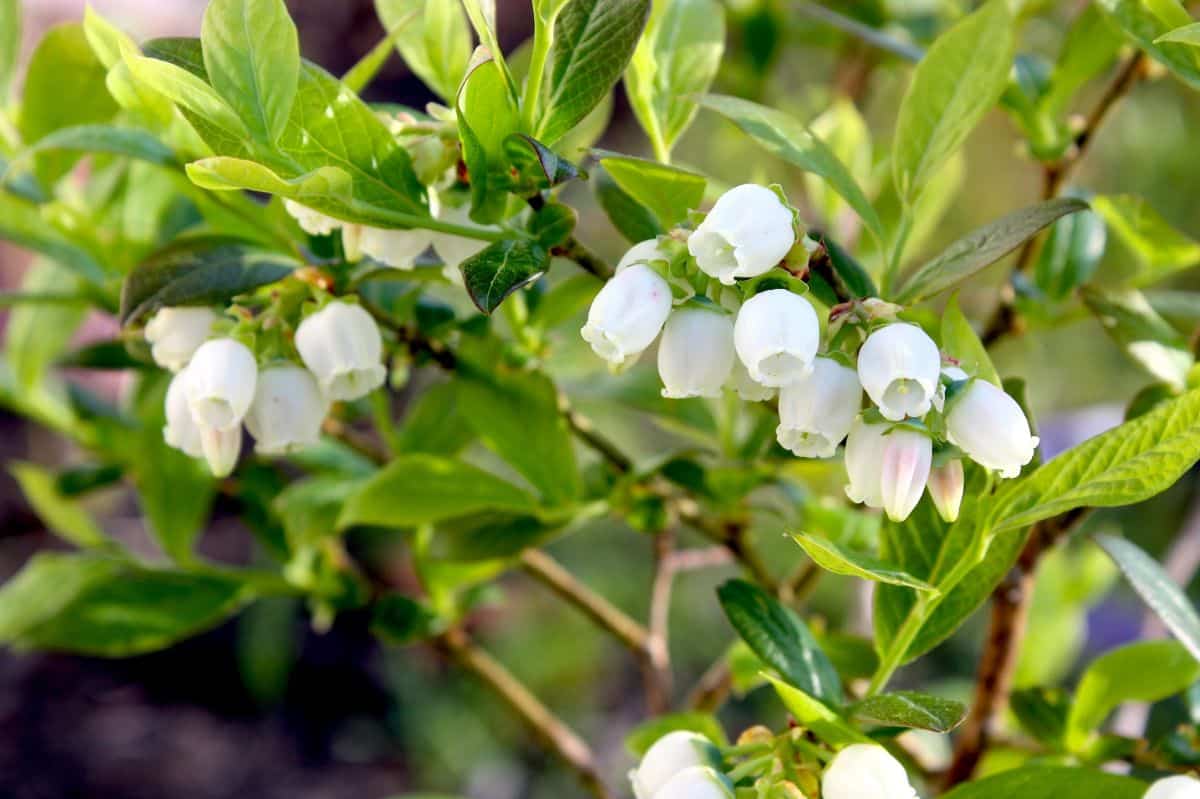
| Plant name: | Blueberries |
| Light requirements: | Full sun to part shade |
| Water requirements: | Moderate |
| Growing zone: | Depends on variety |
| Notable features: | Edible berries |
In the wild, you can often find highbush and lowbush blueberries growing along beaches and roadways, so if you’re looking for a hardy, salt-tolerant plant for your garden, they’re a great option. Not only are blueberries attractive plants, but they also produce some of the tastiest berries you can find. Just imagine growing your own blueberries right in your garden and harvesting them for homemade blueberry pie, muffins, and more!
Because some blueberry cultivars are more salt tolerant than others, it’s important to do your research to find the best blueberries for your landscape. Blueberry shrubs also range in size from lowbush blueberries that grow to about 6” high to massive highbush blueberries that can stretch up to 15’ tall. That difference in size makes some blueberries better for mixed planting arrangements, while other blueberries can hold their own as a backdrop or foundation plants.
8. Columbine (Aquilegia spp.)
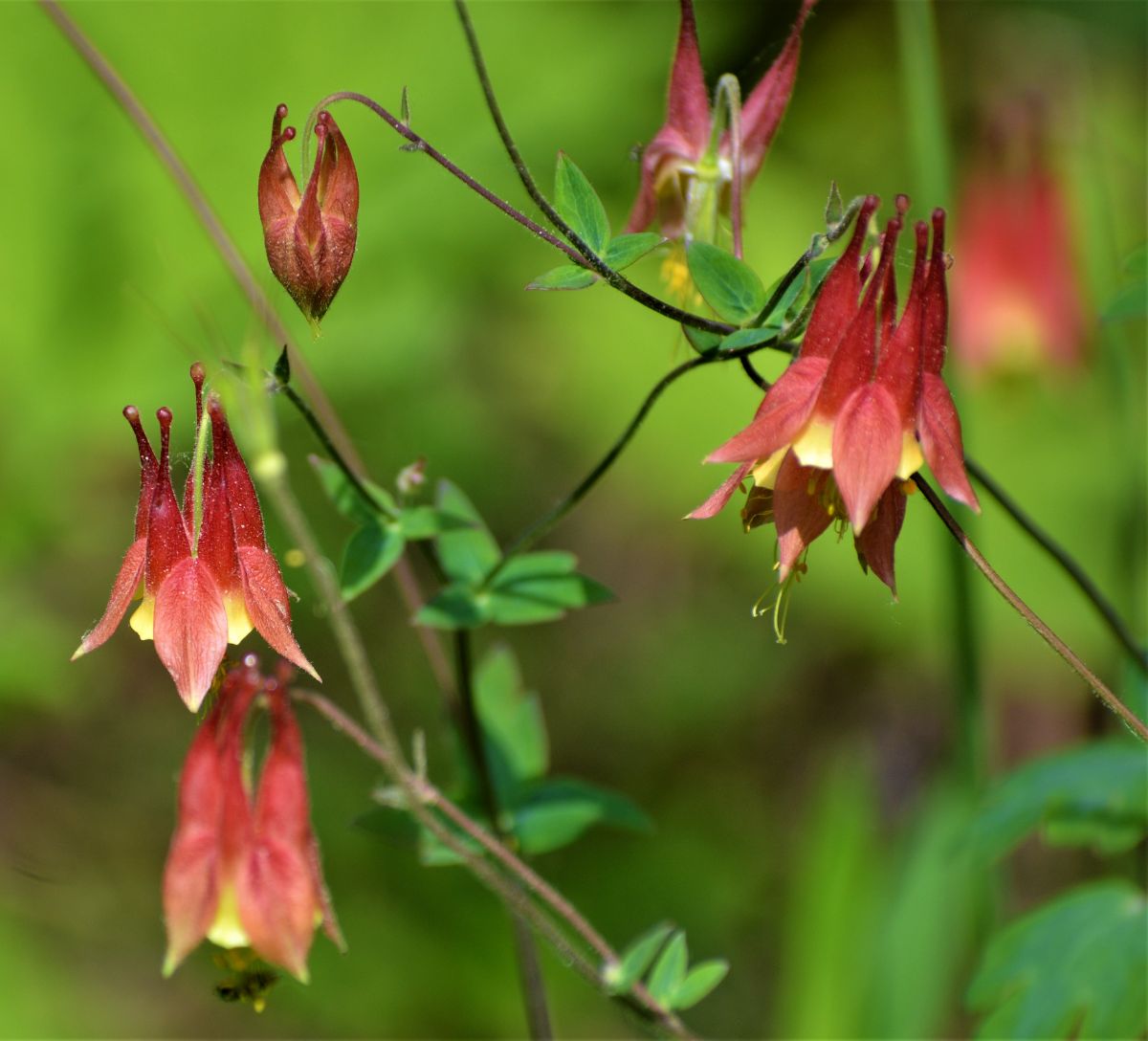
| Plant name: | Columbine |
| Light requirements: | Full sun to part shade |
| Water requirements: | Moderate |
| Growing zone: | Zones 3 to 9 |
| Notable features: | Self-seeding; Good for hummingbirds |
Columbines commonly grow in partial shade, and they are often found on the edges of wooded areas. But columbines also make spectacular garden flowers, and they come in a wide range of colors to suit any taste. Not to mention, these plants are also a favorite stopping ground for pollinators!
Columbines are rated “highly salt tolerant,” allowing you to grow them along roadways and in other areas with high salinity soil. There are over 60 different types of columbines, and some are more salt-resistant than others. But when it comes to pollinator gardens, the eastern red columbine is an obvious pick since hummingbirds adore it!
9. Beach Sunflower (Helianthus debilis)
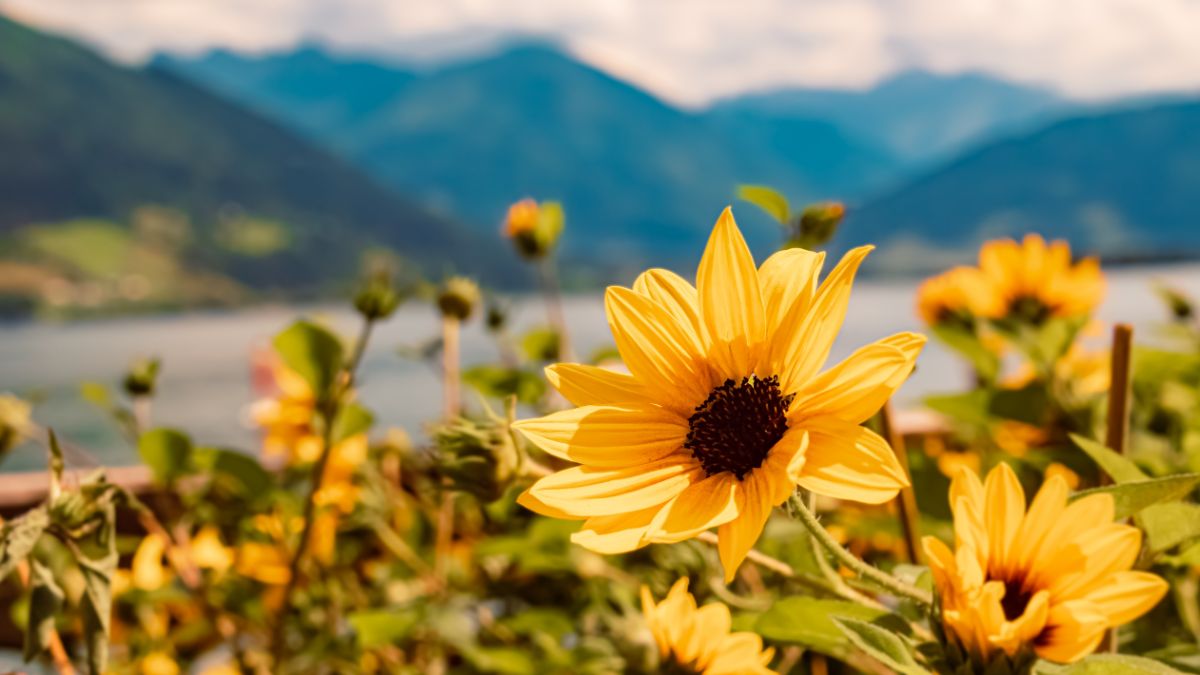
| Plant name: | Beach sunflower |
| Light requirements: | Full sun to part shade |
| Water requirements: | Low |
| Growing zone: | Zones 8 to 10, grows as an annual in cooler areas |
| Notable features: | Drought tolerant; High heat tolerance; Attracts butterflies and birds; Groundcover |
Beach sunflowers are often grown as low-maintenance groundcovers in coastal gardens, where they excel due to their high salt tolerance and drought resistance. These cheerful flowers look a lot like standard sunflowers, but they only grow to about 2 to 4’ tall. In warm climates, beach sunflower grows as a spreading perennial; however, in cooler locations, this plant is kept as a self-seeding annual.
When properly maintained, beach sunflower can bloom almost year-round in warm areas. Flowers measure about 2” across and have golden-yellow petals and a chocolatey brown center. Like standard sunflowers, these plants are very attractive to birds, which will feed on their seedheads when the flowers begin to fade.
10. Hibiscus (Hibiscus spp.)
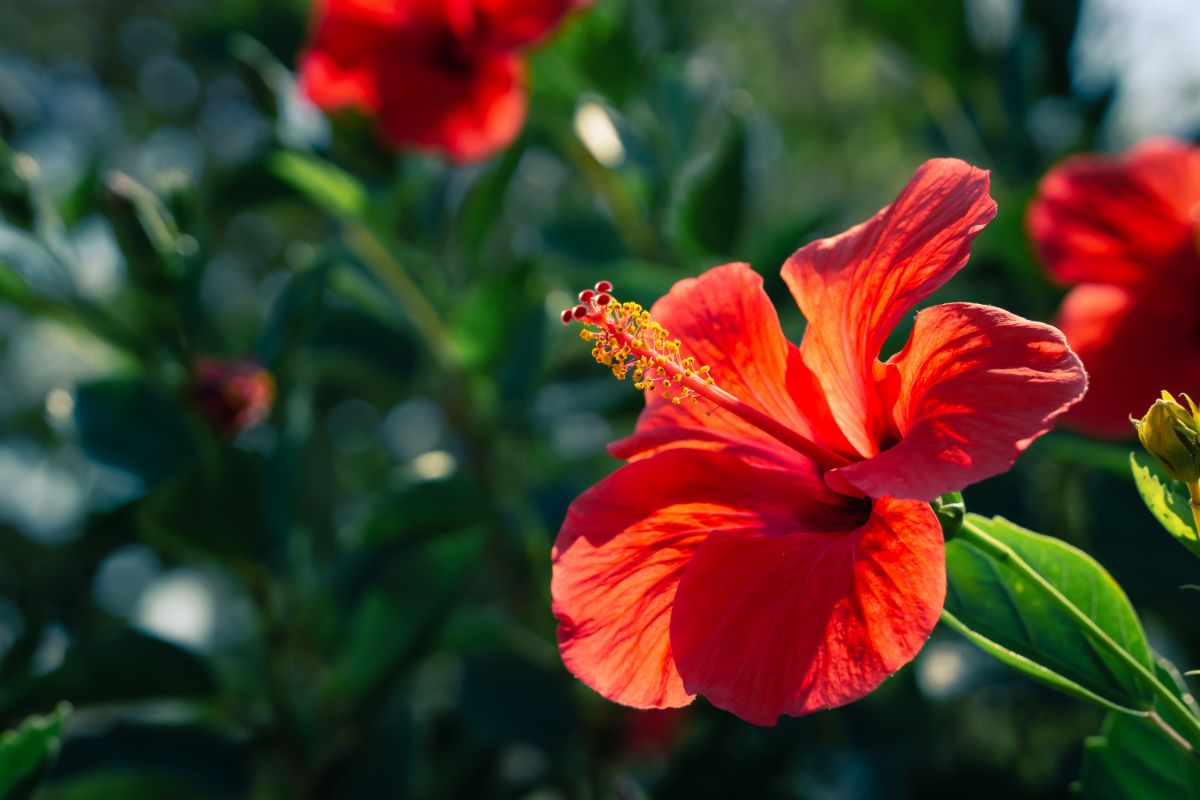
| Plant name: | Hibiscus |
| Light requirements: | Full sun to part shade |
| Water requirements: | Moderate |
| Growing zone: | Depends on variety |
| Notable features: | Showy flowers; Some varieties are edible |
With large, tropical blooms and a carefree growing habit, it’s no wonder why hibiscus are the top plants to grow in beach gardens. As moderately salt-tolerant plants, hibiscus can handle some salt spray, but they shouldn’t be grown in an area that’s inundated with salt. These plants also usually grow in the sun, but some varieties can thrive in part shade.
Most hibiscus varieties hail from warmer climates, and they don’t handle winter well, but there are a few exceptions. Hardy hibiscus cultivars, like ‘Berry Awesome’ and ‘Summerific,’ can grow in gardens in zone 4 and up. You can also find dwarf hibiscus cultivars that are small enough to overwinter inside in pots if you live in an area where winters are harsh.
11. Staghorn Sumac (Rhus typhina)
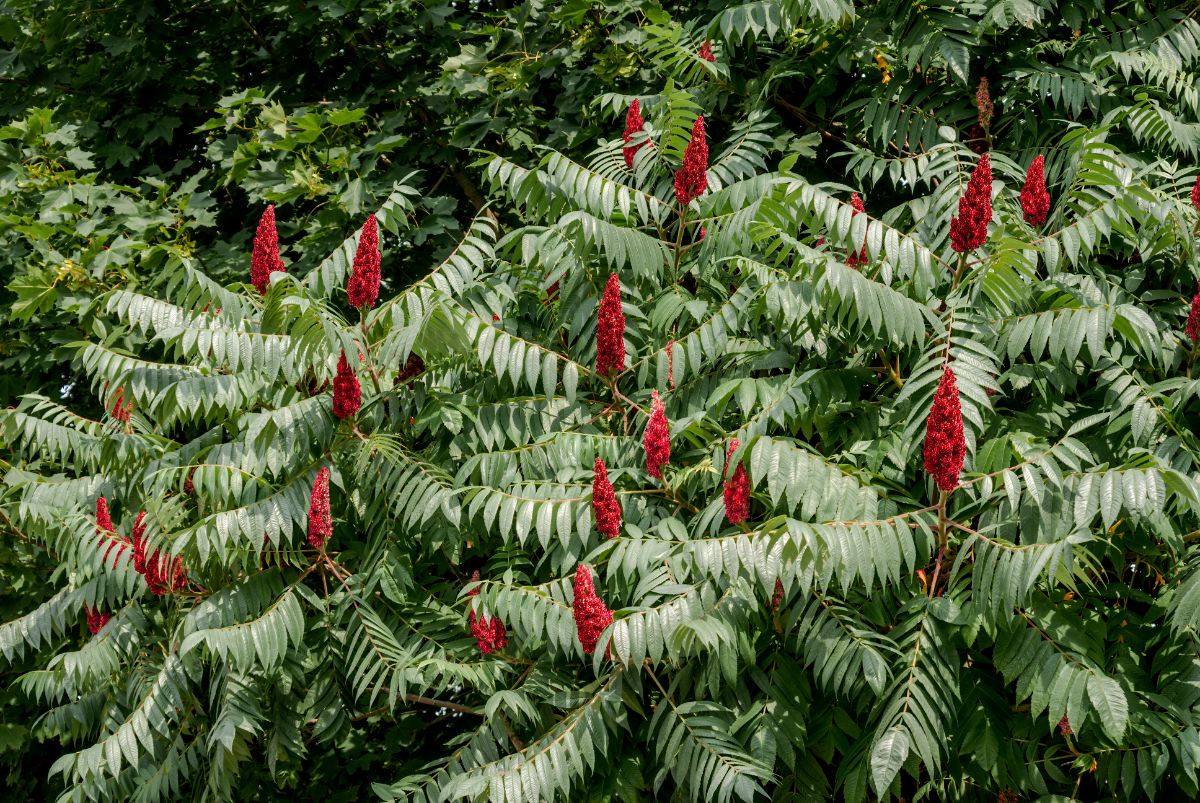
| Plant name: | Staghorn sumac |
| Light requirements: | Full sun to shade |
| Water requirements: | Low |
| Growing zone: | Zones 4 to 8 |
| Notable features: | Drought tolerant; Shade tolerant; Edible; Attracts birds |
Staghorn sumac is a tough plant that can handle a lot of neglect. Native to eastern North America, staghorn sumac is often considered a weed, and it can become invasive in some areas. But with a bit of care and know-how, this plant can offer a lot of benefits.
Unlike the notorious poison sumac, staghorn sumac doesn’t cause itchy skin and rashes. In fact, staghorn sumac’s crimson berries are edible, and they can be brewed into a refreshing lemonade-like drink in summer! Birds also love staghorn sumac berries, and goldfinches, in particular, are sure to flock to your garden if you grow this salt-tolerant beauty.
12. Blanket Flower (Gaillardia spp.)
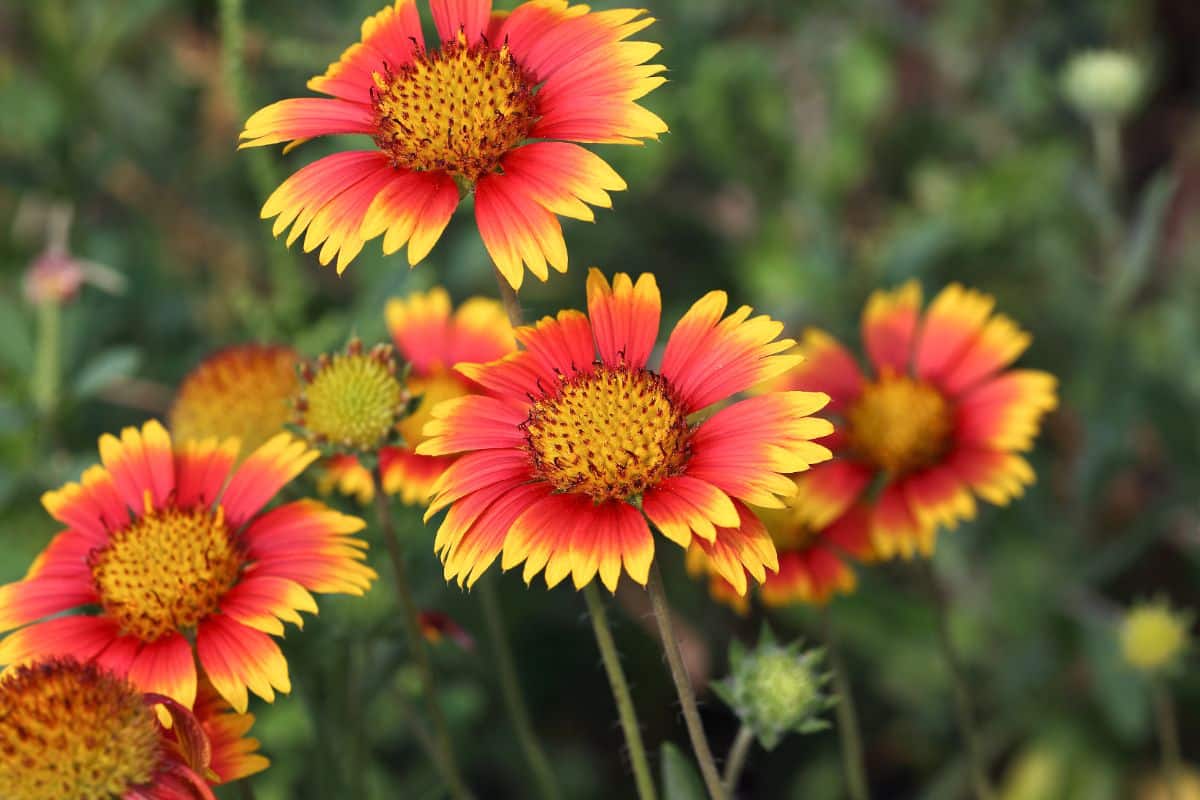
| Plant name: | Blanket flower |
| Light requirements: | Full sun |
| Water requirements: | Moderate to low |
| Growing zone: | Zones 3 to 9 |
| Notable features: | Drought tolerant; Attracts pollinators |
Blanket flowers are another hardy plant that can grow in adverse conditions, including high-salt environments. These short-lived perennials are named for their growth habit, as they form gentle mounds of flowers and “blanket” the soil beneath them as they spread. Daisy-like blooms are brightly colored and provide an important source of nectar and pollen for beneficial insects.
When grown from seeds, blanket flower usually won’t bloom until its second year. But if you want flowers earlier, you can grow these plants from nursery starts instead. Try blanket flower with other salt-tolerant beauties, like goldenrod, daylilies, and asters, for a flower display that just won’t quit!
13. Coral Honeysuckle (Lonicera sempervirens)
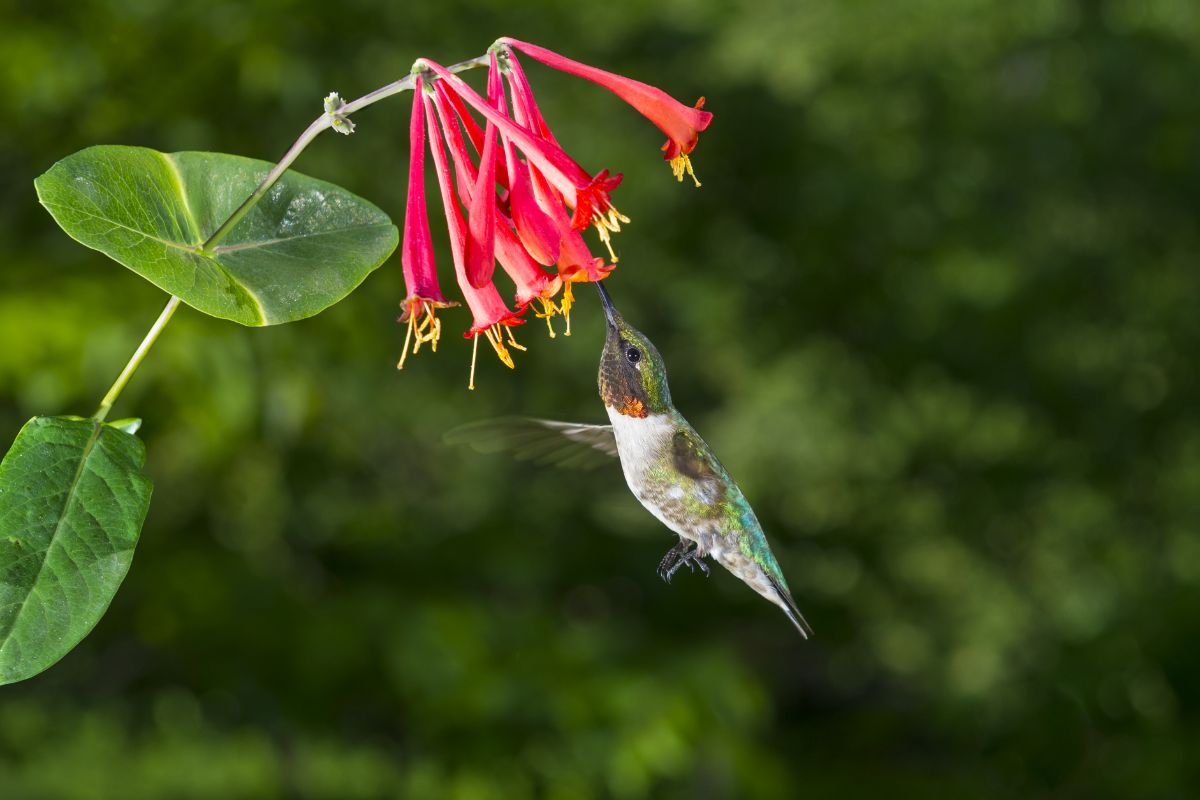
| Plant name: | Coral honeysuckle |
| Light requirements: | Full sun to part shade |
| Water requirements: | Moderate to low |
| Growing zone: | Zones 4 to 10 |
| Notable features: | Attracts hummingbirds; Vines can be trained vertically |
Some honeysuckle plants, like Japanese honeysuckle, are invasive, and they shouldn’t be planted intentionally in gardens. Coral honeysuckle, on the other hand, is native to the United States, and it doesn’t grow aggressively. This plant also displays a good level of salt tolerance, and despite its tropical look, it can grow in gardens in zones 4 and up!
Unlike some other honeysuckle varieties, coral honeysuckle doesn’t have a fragrance, but its vividly colored, tubular flowers pack a punch as is. These vining plants are highly attractive to hummingbirds, and they can be trained to grow up trellises and porch railings. For seasonal privacy and big garden color, coral honeysuckle is a definite must-grow!
14. Ornamental Grasses
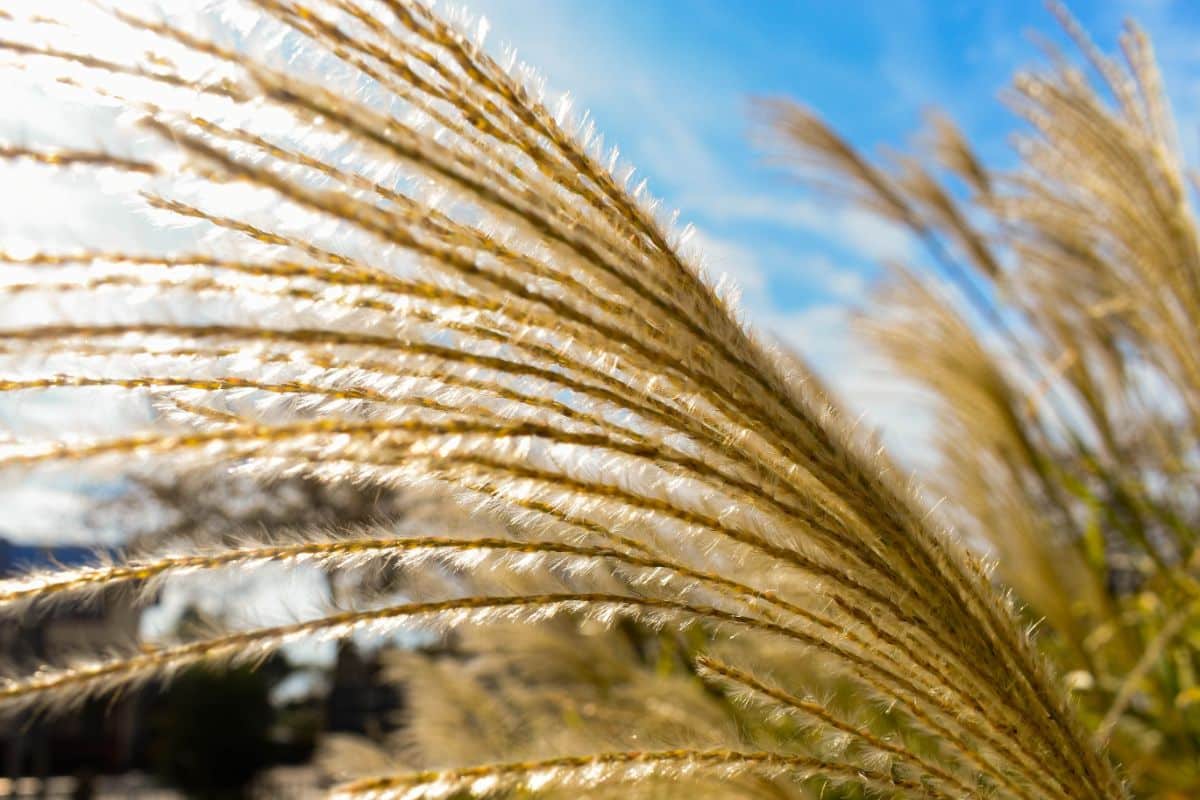
| Plant name: | Ornamental grasses |
| Light requirements: | Depends on variety |
| Water requirements: | Depends on variety |
| Growing zone: | Depends on variety |
| Notable features: | Winter interest; Adds movement to landscape |
Ornamental grasses have a natural, beachy vibe, and planting them in coastal gardens is an easy way to tie your landscape design in with the local environment. Plus, there’s nothing prettier than when the sea breeze catches in ornamental grasses and makes them shimmy and shake like the ocean’s waves! Even if you don’t live near the sea, many ornamental grasses keep their seed heads all winter long, making them exceptional winter interest plants along salty roadways.
Some ornamental grasses have better salt resistance than others. Varieties like blue grama (Bouteloua gracilis), sideoats grama (Bouteloua curtipendula), purple lovegrass (Eragrostis spectabilis) and prairie dropseed (Sporobolus heterolepis) are particularly good for salty environments, but there are other options too. Before selecting an ornamental grass for our garden, do a bit of research to see which varieties you like best.
15. Oleander (Nerium oleander)

| Plant name: | Oleander |
| Light requirements: | Full sun |
| Water requirements: | Moderate to low |
| Growing zone: | Zones 8 to 10 |
| Notable features: | Drought tolerant; Showy flowers; Evergreen foliage |
Oleander has an old-timey feel and evergreen leaves that will provide year-round privacy to sunny porches and walkways. These plants only grow in zones 8 through 10, so they’re not a good choice for cold-weather gardens. But if you live in a warmer area, oleanders will add charm and classic touch to your garden.
Oleanders can grow up to 19’ tall, and they tend to form a gentle, mounding shape as they develop; however, you can keep these plants smaller with pruning or train them to grow as small trees. One thing to note about oleanders is that they are very toxic to humans and pets, and you shouldn’t grow them in areas where small children are present. These plants should also never be burned, and it’s recommended to always wear gloves when handling them.
16. Asters (Aster spp.)
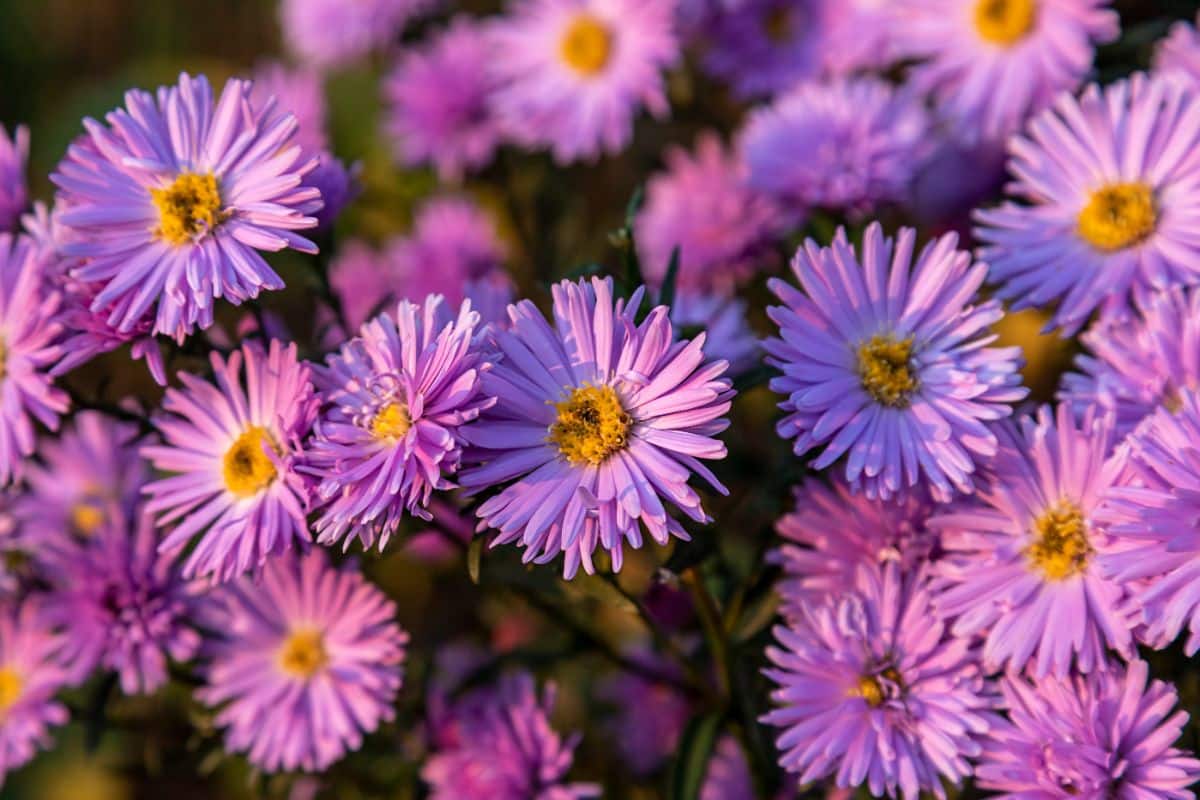
| Plant name: | Asters |
| Light requirements: | Full sun to part shade |
| Water requirements: | Moderate to low |
| Growing zone: | Zones 3 to 8 |
| Notable features: | Attracts pollinators; Drought tolerant |
There are about 170 different types of asters, and some of these plants are better for high-salt areas than others. Many asters grow as wildflowers, and they may spring up in your garden on their own, although you can often find them at plant nurseries too!
Asters have daisy-like flowers with buttery, yellow centers and petals that range from purple to pink and white in tone. Asters can grow between 1 and 6’ tall, and they look particularly appealing when paired with goldenrod. As an autumn-blooming flower, asters provide nectar and pollen for bees late in the season, but single (rather than double-bloom) asters tend to be best for pollinators.
17. Goldenrod (Solidago spp.)
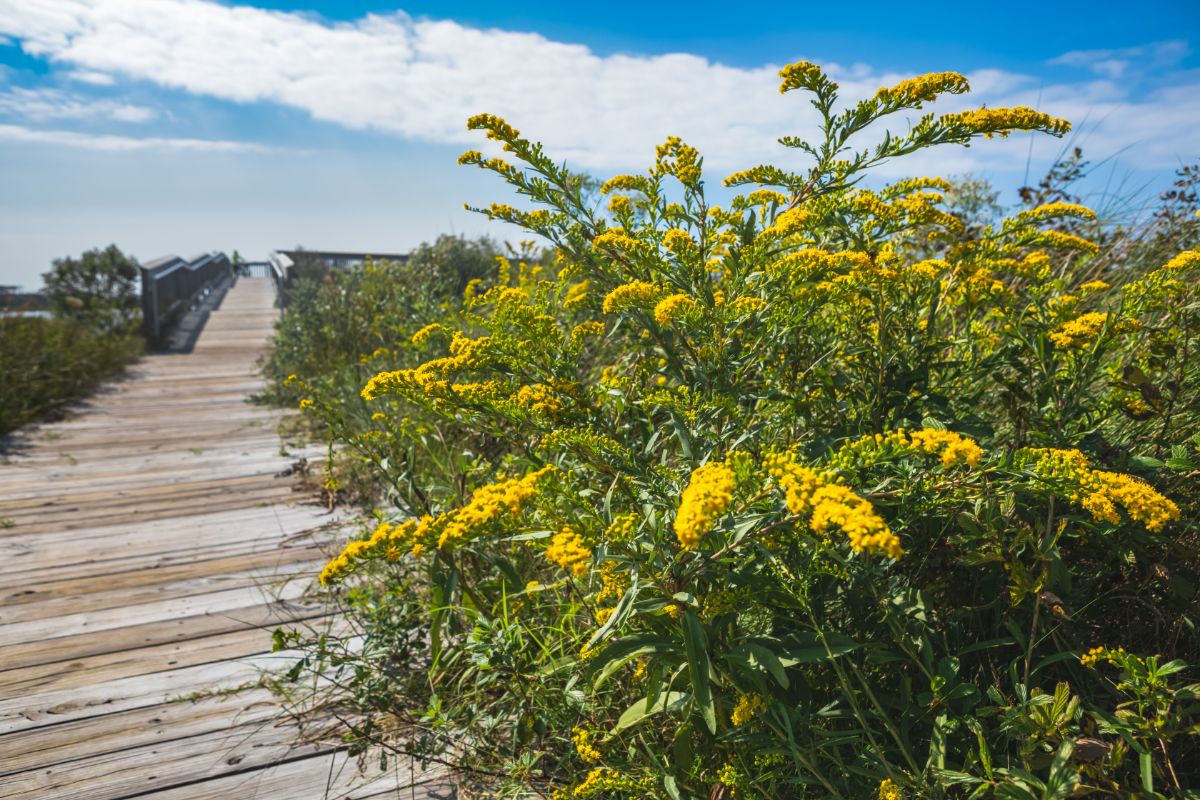
| Plant name: | Goldenrod |
| Light requirements: | Full sun to part shade |
| Water requirements: | Moderate to low |
| Growing zone: | Zones 2 to 8 |
| Notable features: | Attracts pollinators; Ultra cold hardy; Drought tolerant |
Goldenrod and asters have very similar growing requirements, which is why they are often planted together in garden beds. Goldenrods also bloom late in the season, and they have very distinct, bright yellow flowers that come in different shapes depending on the type of goldenrod you grow. As with asters, some goldenrods have better salt resistance than others, and ‘Northern Seaside Goldenrod’ and ‘White Goldenrod’ are at the top of the list for salt tolerance.
Often, gardeners are reluctant to plant goldenrod because they associate this plant with seasonal allergies. In truth, it’s actually the similar-looking ragweed that’s responsible for allergy symptoms, while goldenrod is simply an attractive, pollinator-friendly plant. This plant is also ideal for cut flowers, and you can use it to make a natural yellow dye!
18. Daylilies (Hemerocallis spp.)
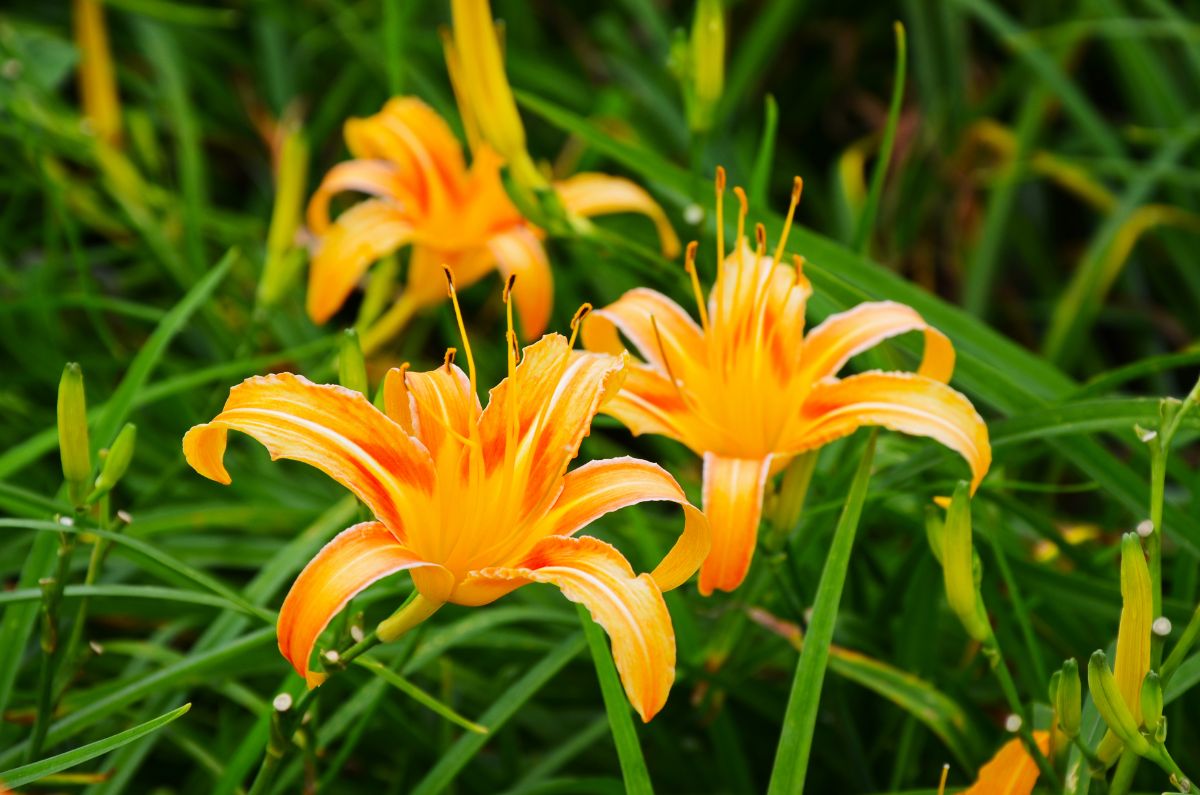
| Plant name: | Daylilies |
| Light requirements: | Full sun to part shade |
| Water requirements: | Moderate to low |
| Growing zone: | Zones 2 to 11 |
| Notable features: | Edible flowers; Divides easily; Ultra cold hardy; Drought tolerant |
Daylilies are adaptable plants that grow just about anywhere, including in part shade, full sun, or in gardens with higher than average salt levels. Plant daylilies near roadways or in beachside gardens; these laid-back plants will thrive either way. And, while you may be most familiar with orange daylilies, you can find varieties with yellow, cream, purple, or red flowers too!
With their tall flowers and grass-like leaves, daylily plants look spectacular on their own, but they are even more eye-catching when planted in a large grouping of at least 3 to 5 plants. Over time, daylily plants will naturally spread, and it’s a good idea to divide your plants every 3 to 5 years. Deadheading old daylily flowers will keep your plants looking trim and tidy, and it will also encourage them to produce even more blooms.
Summary
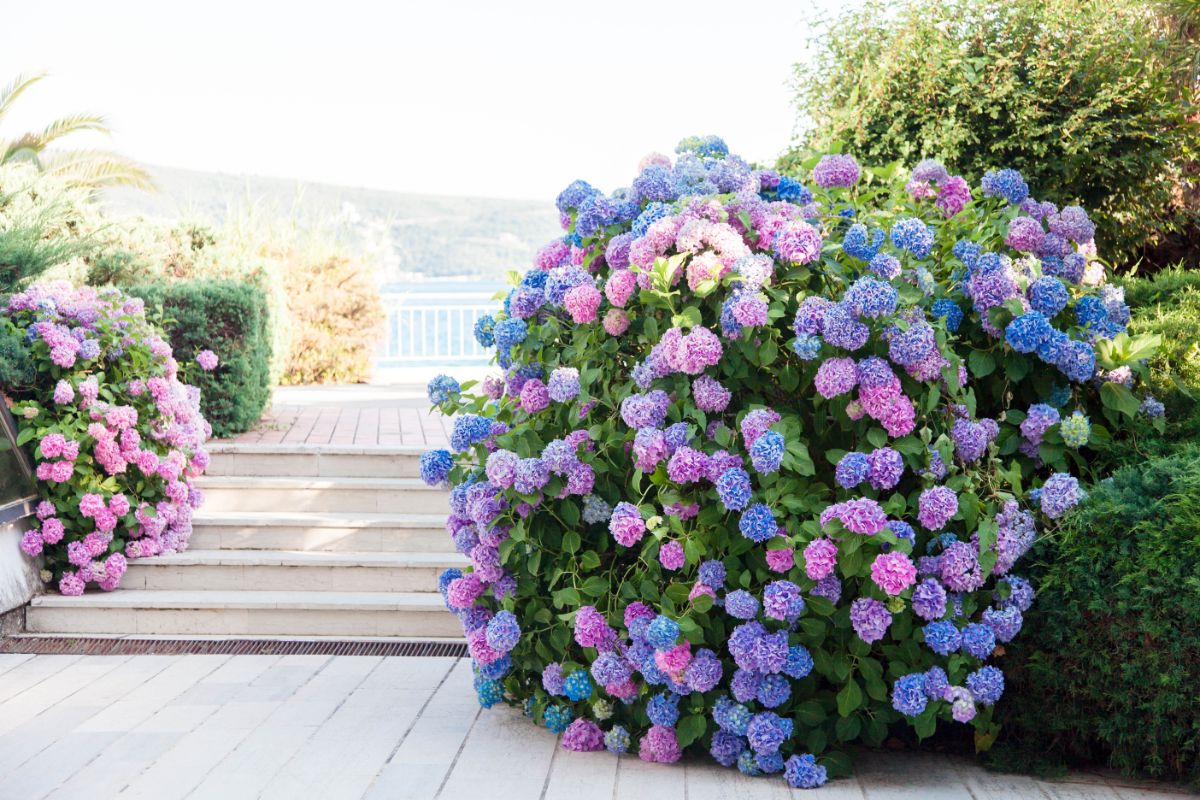
Beachside gardens and salty roadways can make gardening a challenge and wreak havoc on many plants. But if you choose the right salt-tolerant plants from the outset, you can simplify your plant care regimen and set yourself up for gardening success.
No matter what climate you live in, you can find plenty of tough-as-nails plants to grow in even the most challenging conditions. For more adaptable and hardy plants, check out our guide on shade-tolerant perennials or learn how to improve sandy soils right here.

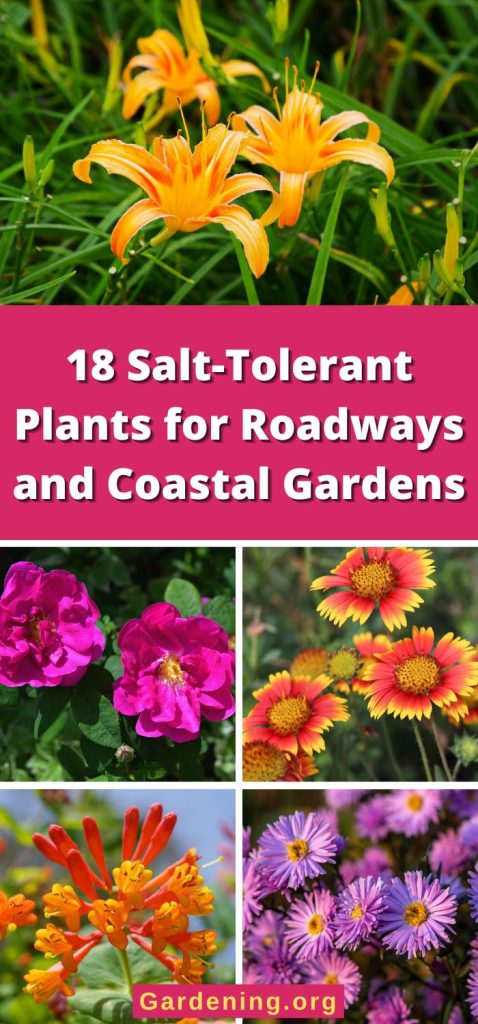
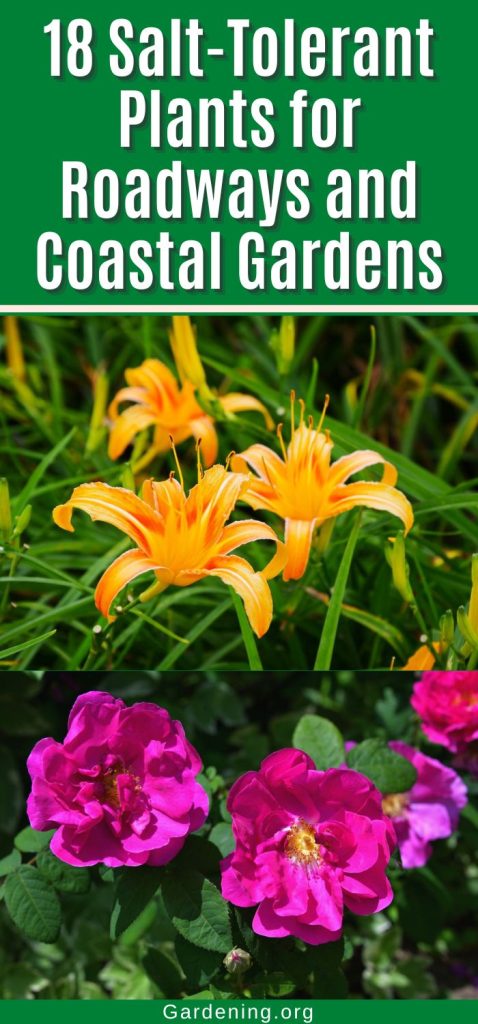
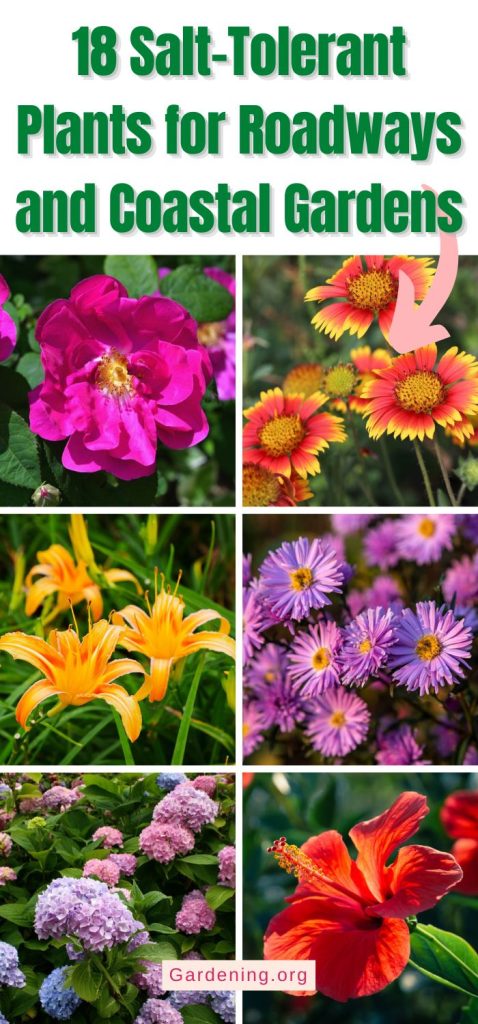
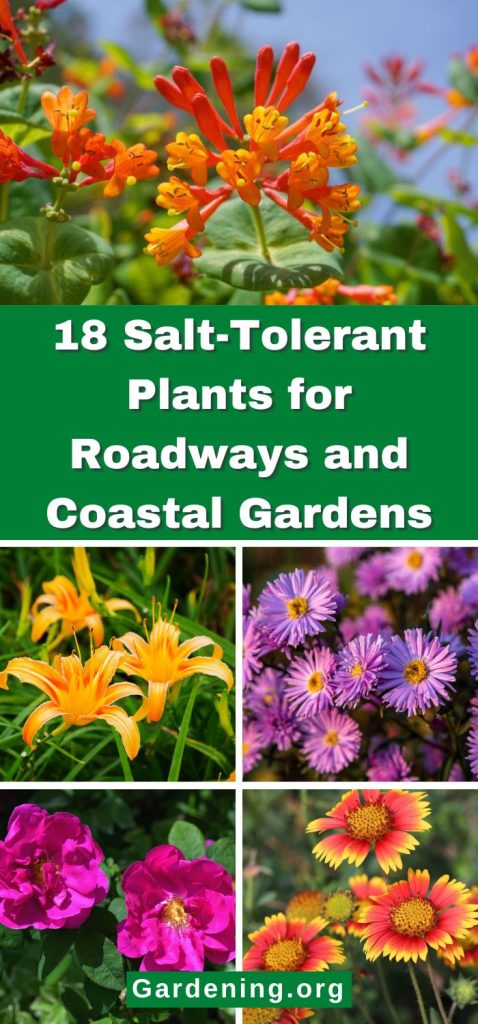
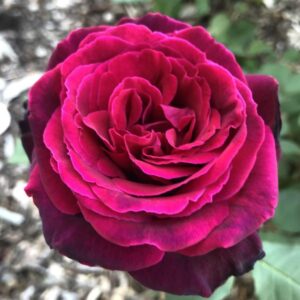
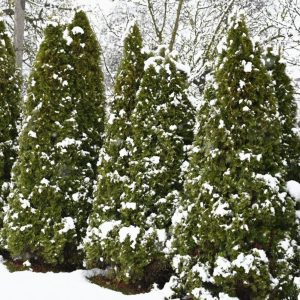


Jodie
Thank you so much what a beautiful display and very much knowledge thank you so much you guys are great